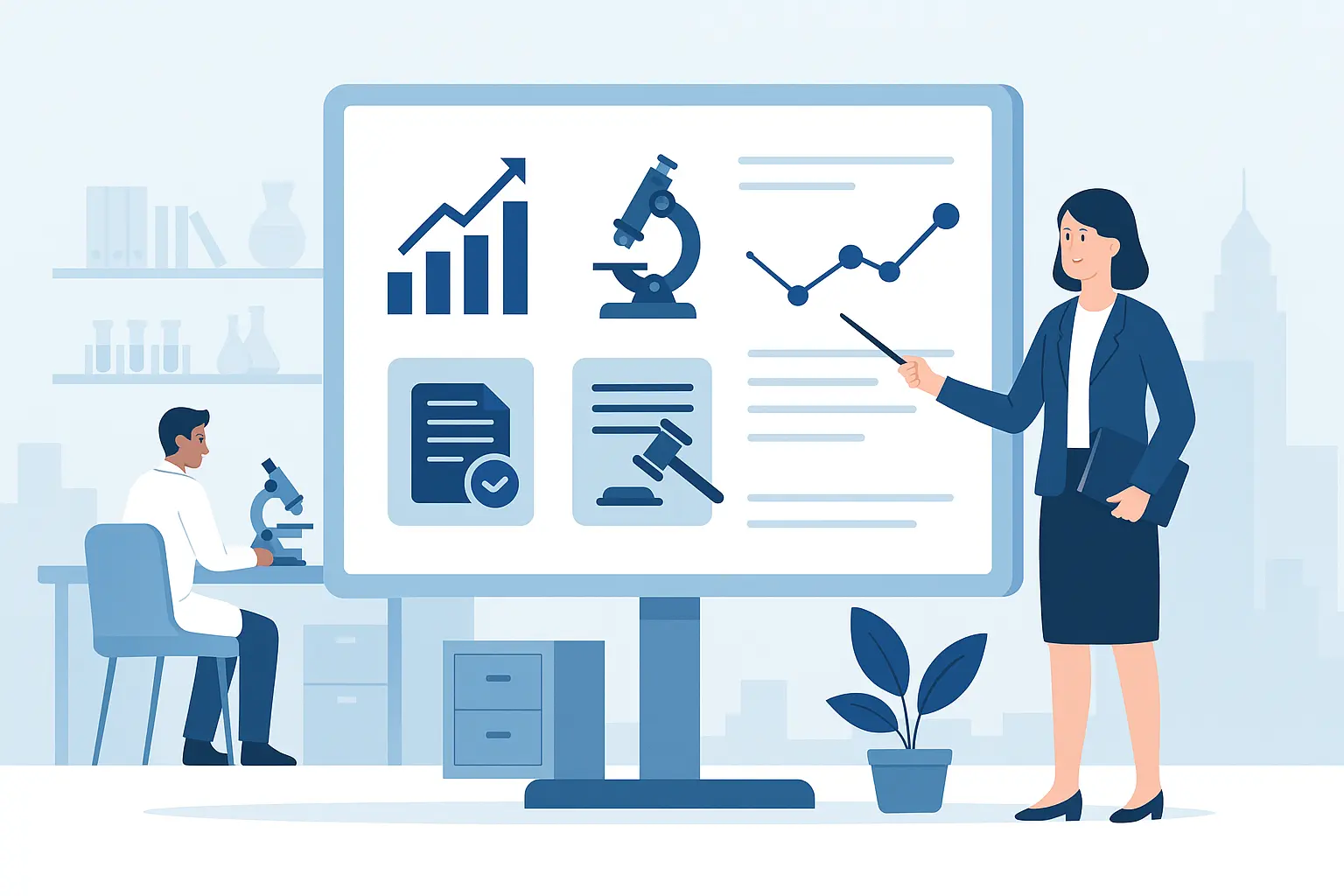Industry Insights
Top Laboratory Trends for the New Year
October 6, 2025
Editor’s Note: This Industry Insights post was originally published on December 4, 2024.
As we head into the new year, now’s a good time to reflect on the past several months and consider what’s on the horizon.
Yes, the future is unpredictable, but that doesn’t mean we as active participants in the medical laboratory industry should stop making predictions.
With that in mind, we strongly encourage laboratory professionals who haven’t yet done so to explore the October/November issue of Clinical Lab Products featuring “17 Laboratory Predictions for 2025.”
As in previous years, CLP gathered insights from leading industry experts, asking them to share the key laboratory trends they expect to shape the year ahead.
What follows is a summary of takeaways from the CLP article.
More Growth in Automation and AI Predicted
Not surprisingly automation and AI emerged as the leading trends for the second consecutive year. Alongside them, new trends driven by demographic shifts, advancements in laboratory information systems (LIS systems) and other testing technology, and an increasing focus on emerging disease states were also discussed.
Top Trends:
Automation and AI:
- These dominant trends will continue to be critical for addressing workforce shortages and improving clinical and pathology lab management efficiency.
- The adoption of advanced robotics and AI-powered diagnostics is expected to accelerate.
- AI applications include faster operations, predictive analytics, laboratory billing (lab revenue cycle management) automation, and precision in clinical outcomes.
Collaborative Innovation:
- Enhanced partnerships between research institutions, pharma, and medtech companies to develop diagnostics and therapies.
Specialized Testing:
- Increase in tests for antimicrobial resistance, allergies, autoimmune diseases, and molecular diagnostics.
Discover More: The Best Laboratory Information System Companies and the Advantages They Offer to Their Laboratory Clients

AI and the Power to Reshape Laboratory Revenue Cycle Management
LigoLab CEO Suren Avunjian, a recognized thought leader in the pathology lab software and laboratory informatics space, contributed to the CLP article and emphasized the transformative potential of AI in revolutionizing the laboratory billing process in the coming year.
As a champion of innovation, Avunjian pointed to several AI-driven practices that are transforming the industry and rapidly evolving into next-generation laboratory billing solutions.
Automation for Data Entry and ICD/CPT Coding:
- AI-powered systems can automatically populate and extract relevant information from laboratory information systems (LIS lab applications) and assign appropriate ICD and CPT codes for enhanced lab billing. AI algorithms and Machine Learning (ML) technology can learn from historical data to improve coding accuracy with every case.
Interpretation of Contracts and Rule Building for Payer Management:
- One of the most intricate challenges in laboratory billing is managing contracts with payers, including insurance companies and government programs. These contracts often contain complex terms, varying reimbursement rates, and detailed clauses that can be difficult to interpret and enforce manually. AI and ML technologies can automate the interpretation of these contracts, build actionable lab billing rules, and detect payers' mispayments or underpayments.
- Once the contract terms are extracted, AI systems can automatically generate lab billing rules aligning with each payer's requirements. These rules can be integrated into the laboratory billing system, ensuring all claims comply with contractual obligations.
- AI can continuously monitor incoming payments and compare them against expected amounts based on the contractual agreements and services rendered. AI can flag payment mistakes such as underpayments by analyzing payment patterns and discrepancies,
- AI analytics can provide laboratories with data-driven insights into payer behaviors, common areas of dispute, and financial impacts of specific contract terms. This information is invaluable during contract negotiations.
Predictive Analytics and Denial Management:
- AI and ML models can predict which claims are likely to be denied (based on historical data) thus allowing lab billing teams to address potential RCM cycle issues before submission, increase claim acceptance rates, and reduce the time spent on resubmissions.
Real-Time Compliance Monitoring:
- AI-powered systems stay updated with the latest regulatory changes and ensure that the RCM cycle adheres to current laws and guidelines. This minimizes legal risks and ensures compliance without manual oversight.
Improved Patient Experiences:
- AI chatbots and automated systems can handle patient inquiries regarding lab billing, provide estimates, and set up payment plans. This improves patient satisfaction and encourages timely payments.
Avunjian also pointed out a less obvious benefit of AI integration: its potential to address workforce shortages by streamlining processes and reducing manual workloads. His insights underlined AI’s role in advancing efficiency and driving sustainable growth in laboratory operations.
He believes AI and ML solutions will become integral laboratory billing components because the interpretation of large and complex data sets and continuous learning capabilities of AI and ML algorithms means these systems will only become more accurate and efficient over time. Clinical laboratories and pathology practices that adopt these technologies early will gain a competitive advantage through cost savings and improved operational efficiency.
Industry Insights: Navigating the Coding Minefield - Labs Struggle with RCM Rejections Amid Rising Scrutiny from Payers

Integrated Laboratory Billing Solutions: The Key to Preventing Revenue Leakage
Avunjian next highlighted the critical importance of addressing lab billing inefficiencies in today’s era of shrinking margins and rising operational costs by emphasizing laboratory information system (LIS software) and lab revenue cycle management (lab RCM) integration as key to overcoming these challenges.
By positioning LIS software and lab RCM integration as a cornerstone of modern laboratory operations, Avunjian underscored its positive impact on business and compliance.
Avunjian further highlighted the other ancillary benefits of medical LIS and laboratory billing system integration, including reduced IT maintenance costs, fewer licensing needs, and increased automation.
End-to-End Data Integrity:
- An all-in-one (integrated) LIS system and lab billing platform ensures consistent and accurate data flow from start to finish by maintaining a single source of truth for orders, results, and claims. This eliminates redundant data entry and discrepancies between two disparate laboratory software systems that result in denials and delayed payments.
Faster Lab RCM Cycle:
- The unification of LIS system and lab billing workflows accelerates reimbursement cycles by connecting technical and financial operations within a single, cohesive platform. It also provides real-time access to third-party services for patient demographic verification, insurance eligibility and discovery, claim submission, and claim status, all within one source of informatics truth.
Simplified Compliance:
- An all-in-one lab information system and lab RCM platform simplifies compliance with regulations like HIPAA and CLIA by ensuring all transactions are traceable and secure. It also provides comprehensive analytics and operational insights that the lab can use to eliminate bottlenecks and improve processes.
Reduced IT Costs:
- LIS system and laboratory billing synergy reduces IT maintenance costs by eliminating the need for multiple software licenses and support teams. An integrated platform such as this optimizes resource utilization, reduces administrative overhead, and maximizes automation.
Adaptability:
- An integrated medical LIS and lab RCM platform is also much more adaptable to changes in laboratory billing codes, regulatory requirements, demographic changes, and lab services, all of which better support lab growth and scalability when compared against multi-system diagnostic lab software solutions.
Avunjian believes labs can truly help themselves with improved efficiency, accuracy, compliance, and financial performance by integrating their LIS systems and laboratory billing solutions into a single source of data backed by automation.
Discover More: Maximizing Your Lab’s Profitability: The Case for In-House Lab Billing
Non-Integrated Laboratory Billing Systems and the Associated Costs
In addition to the CLP article cited above, here’s another opportunity for you and your colleagues to discover how a unified LIS system with advanced laboratory billing functionality can transform the operational and financial performance of your testing organization.
On-Demand Webinar: Unifying Technical and Financial Operations to Minimize Denials and Prevent Revenue Leakage






